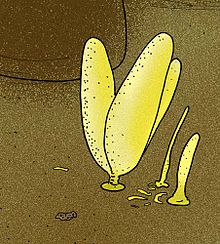Tawuia is a millimetric disc-shaped, most likely multicellular macrofossil from the Neoproterozoic. It is considered to be synonymous with Chuaria and Longfengshania, which, in turn, are thought to represent different life stages of the same organism.[1]
| Tawuia Temporal range: Statherian to Cambrian Stage 3,
| |
|---|---|

| |
| Fossil specimen, Geological Museum of China | |
| Scientific classification | |
| (unranked): | incertae sedis |
| Genus: | †Tawuia H.J.Hofmann, 1979 |


Tawuia describes a more sausage- or crescent-shaped fossil; Chuaria refers to more discoidal instances.
The fossils are often preserved as organic compressions. They are considered to represent microbial structures;[1] some authors affiliate them with slime molds[1]. Stratigraphically, they range from 1,630 million years ago[2] to the early Cambrian[3]
Chuaria is multicellular.
References
edit- ^ a b c Teyssèdre, B. (2003), "Trois classes de fossiles precambriens pour un meme taxon", Comptes Rendus Palevol (in French), 6 (503): 508–510, doi:10.1016/j.crpv.2003.09.023[dead link]
- ^ Srivastava, P.; Bali, R. (2006). "Proterozoic carbonaceous remains from the Chorhat Sandstone: oldest fossils of the Vindhyan Supergroup, Central India". Geobios. 39 (6): 873–878. Bibcode:2006Geobi..39..873S. doi:10.1016/j.geobios.2006.02.001.
- ^ Li, Rui-Yun; Fu, Dong-Jing; Zhang, Xing-Liang (22 December 2022). "Chuaria Walcott from the early Cambrian Qingjiang biota: a taxon persisted for billions of years". Palaeoworld. 33 (1): 11–21. doi:10.1016/j.palwor.2022.12.008.